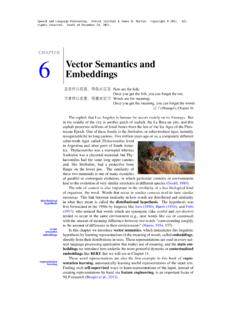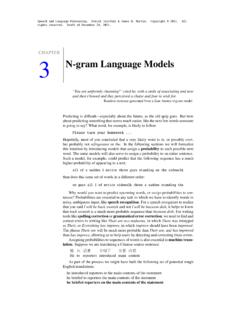Transcription of Introduction to Statistics - SAGE Publications Inc
1 CHAPTER1 Introduction to StatisticsLEARNING OBJECTIVESA fter reading this chapter , you should be able to:1 Distinguish between descriptive and inferential Explain how samples and populations, as well as a sample statistic and population parameter, Describe three research methods commonly used in behavioral State the four scales of measurement and provide an example for Distinguish between qualitative and quantitative Determine whether a value is discrete or Enter data into SPSS by placing each group in separate columns and each group in a single column (coding is required). Descriptive and Inferential Statistics in Scales of Types of Research in Focus: Types of Data and Scales of SPSS in Focus: Entering and Defining Variables2 PART I: Introduction AND DESCRIPTIVE DESCRIPTIVE AND INFERENTIAL STATISTICSWhy should you study Statistics ?
2 The topic can be intimidating, and rarely does anyone tell you, Oh, that s an easy course .. take Statistics ! Statistics is a branch of mathematics used to summarize, analyze, and interpret what we observe to make sense or meaning of our observations. A family counselor may use Statistics to describe patient behavior and the effectiveness of a treatment program. A social psychologist may use Statistics to summarize peer pressure among teenagers and interpret the causes. A college professor may give students a survey to summarize and interpret how much they like (or dislike) the course. In each case, the counselor, psychologist, and professor make use of Statistics to do their reason it is important to study Statistics can be described by the words of Mark Twain: There are lies, damned lies and Statistics . He meant that Statistics can be deceiving and so can interpreting them.
3 Statistics are all around you from your college grade point average (GPA) to a Newsweek poll predicting which politi-cal candidate is likely to win an election. In each case, Statistics are used to inform you. The challenge as you move into your careers is to be able to identify Statistics and to interpret what they mean. Statistics are part of your everyday life, and they are subject to interpretation. The interpreter, of course, is is a branch of mathematics used to summarize, analyze, and interpret a group of numbers or begin by introducing two general types of Statistics : Descriptive Statistics : Statistics that summarize observations. Inferential Statistics : Statistics used to interpret the meaning of descriptive book describes how to apply and interpret both types of Statistics in sci-ence and in practice to make you a more informed interpreter of the statistical information you encounter inside and outside of the classroom.
4 Figure is a sche-matic diagram of the chapter organization of this book, showing which chapters focus on descriptive Statistics and which focus on inferential STATISTICSR esearchers can measure many behavioral variables, such as love, anxiety, mem-ory, and thought. Often, hundreds or thousands of measurements are made, and procedures were developed to organize, summarize, and make sense of these mea-sures. These procedures, referred to as descriptive Statistics , are specifically used to describe or summarize numeric observations, referred to as data. To illustrate, suppose we want to study anxiety among college students. We could describe anxi-ety, then, as a state or feeling of worry and nervousness. This certainly describes anxiety, but not numerically (or in a way that allows us to measure anxiety). Instead, we could state that anxiety is the number of times students fidget during a class presentation.
5 Now anxiety is defined as a number. We may observe 50, 100, or 1,000 students give a class presentation and record the number of times each DEFINITION chapter 1: Introduction TO Statistics 3student fidgeted. Presenting a spreadsheet with the number for each individual student is not very clear. For this reason, researchers use descriptive Statistics to summarize sets of individual measurements so they can be clearly presented and Statistics are procedures used to summarize, organize, and make sense of a set of scores or Statistics are typically presented graphically, in tabular form (in tables), or as summary Statistics (single values).Data (plural) are measurements or observations that are typically numeric. A datum (singular) is a single measurement or observation, usually referred to as a score or raw are generally presented in summary.
6 Typically, this means that data are presented graphically, in tabular form (in tables), or as summary Statistics ( , an average). For example, the number of times each individual fidgeted is not all that meaningful, whereas the average (mean), middle (median), or most common (mode) number of times among all individuals is more meaningful. Tables and graphs serve a similar purpose to summarize large and small sets of often, researchers collect data from a portion of individuals in a group of interest. For example, the 50, 100, or 1,000 students in the anxiety example would not constitute all students in college. Hence, these researchers collected anxiety data from some students, not all. So researchers require statistical procedures that allow them to infer what the effects of anxiety are among all students of interest using only the portion of data they : Descriptive Statistics summarize data to make sense or meaning of a list of numeric ansition fromdescriptive toinferential Statistics (Chapters 6-7)Inferential Statistics (Chapters 8-18)StatisticsDescriptive Statistics (Chapters 2-5)FIGURE A general overview of this book.
7 This book begins with an Introduction to descriptive Statistics (Chapters 2 5) and then uses descriptive Statistics to transition (Chapters 6 7) to a discussion of inferential Statistics (Chapters 8 18).DEFINITION4 PART I: Introduction AND DESCRIPTIVE STATISTICSINFERENTIAL STATISTICSThe problem described in the last paragraph is that most scientists have limited access to the phenomena they study, especially behavioral phenomena. As a result, researchers use procedures that allow them to interpret or infer the meaning of data. These procedures are called inferential Statistics are procedures used that allow researchers to infer or generalize observations made with samples to the larger population from which they were illustrate, let s continue with the college student anxiety example. All students enrolled in college would constitute the population.
8 This is the group that researchers want to learn more about. Specifically, they want to learn more about characteristics in this population, called population parameters. The characteristics of interest are typically some descriptive statistic. In the anx-iety example, the characteristic of interest is anxiety, specifically measured as the number of times students fidget during a class presentation. Unfortunately, in behavioral research, scientists rarely know what these popu-lation parameters are since they rarely have access to an entire population. They simply do not have the time, money, or other resources to even consider studying all students enrolled in population is defined as the set of all individuals, items, or data of interest. This is the group about which scientists will characteristic (usually numeric) that describes a population is referred to as a population alternative is to select a portion or sample of individuals in the popula-tion.
9 Selecting a sample is more practical, and most scientific research you read comes from samples and not populations. Going back to our example, this means that selecting a portion of students from the larger population of all students enrolled in college would constitute a sample. A characteristic that describes a sample is called a sample statistic this is similar to a parameter, except it describes characteristics in a sample and not a population. Inferential Statistics use the characteristics in a sample to infer what the unknown parameters are in a given population. In this way, as shown in Figure , a sample is selected from a population to learn more about the characteristics in the population of sample is defined as a set of selected individuals, items, or data taken from a population of characteristic (usually numeric) that describes a sample is referred to as a sample : Inferential Statistics are used to help the researcher infer how well Statistics in a sample reflect parameters in a chapter 1: Introduction TO Statistics 5 Population: All studentsenrolled in : 50 students 100 students 1,000 studentsObserve the number of times each student fidgets during a class presentation in each conclusions about anxiety levels for the entire population of students (not just among those in each sample).
10 FIGURE Samples and populations. In this example, levels of anxiety were measured in a sample of 50, 100, or 1,000 college students. Researchers will observe anxiety in each sample. Then they will use inferential Statistics to generalize their observations in each sample to the larger population, from which each sample was SENSE: Populations and SamplesA population is identified as any group of interest, whether that group is all students worldwide or all students in a professor s class. Think of any group you are interested in. Maybe you want to understand why college students join fraternities and sororities. So students who join fraternities and sororities is the group you re interested in. Hence, this group is now a population of interest, to you anyways. You identified a population of interest just as researchers identify populations they are interested that researchers collect samples only because they do not have access to all individuals in a population.














